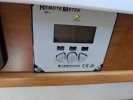2016 Cutwater 30CB - New to me
My house batteries die within an hour or two of being on the water. They have a date of 9/20, so I am guessing 2020 or 5 years old now.
Current Battery x 4 = 12V 725CCA 890MCA 100Ah 190RC Deka Dual Purpose Marine Battery
I was thinking of replacing them with AGM batteries from Canadian Tire.
MOTOMASTER NAUTILUS AGM Group Size 31 Battery 1000 marine crank amps, 105 amp hours, 200 minutes reserve capacity
I also have solar panels that come with the boat. I am not able to tell if it is charging the house batteries.
The sun saver duo has all the dip switches all on off, which means 90/10%. I guess 90% to the house? #3 changes this to 50/50
I was trying to learn the Remote Meter to see if I can tell if they are getting any charge, I could not tell. After pushing a few buttons, the screen went mostly blank.
Any advice is appreciated.
Thanks
Glenn
My house batteries die within an hour or two of being on the water. They have a date of 9/20, so I am guessing 2020 or 5 years old now.
Current Battery x 4 = 12V 725CCA 890MCA 100Ah 190RC Deka Dual Purpose Marine Battery
I was thinking of replacing them with AGM batteries from Canadian Tire.
MOTOMASTER NAUTILUS AGM Group Size 31 Battery 1000 marine crank amps, 105 amp hours, 200 minutes reserve capacity
I also have solar panels that come with the boat. I am not able to tell if it is charging the house batteries.
The sun saver duo has all the dip switches all on off, which means 90/10%. I guess 90% to the house? #3 changes this to 50/50
I was trying to learn the Remote Meter to see if I can tell if they are getting any charge, I could not tell. After pushing a few buttons, the screen went mostly blank.
Any advice is appreciated.

Thanks
Glenn
